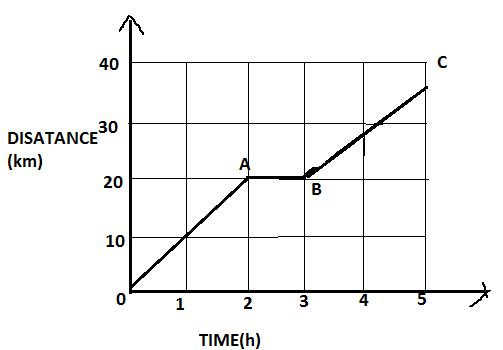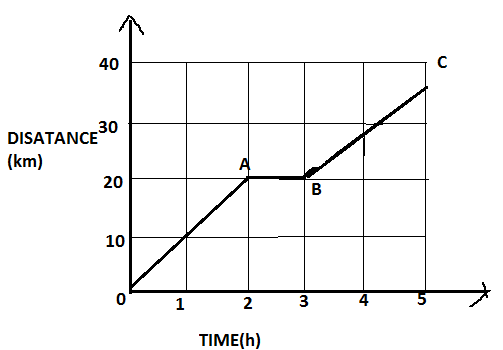
Answer
432.3k+ views
Hint: We know that motion is a change in the position of an object with time. In order to specify the position, we need to use a reference point and a set of axes. Graphical analysis is a convenient method of studying the motion of particles. It can be effectively applied to analyze the motion of a particle.
Complete step by step answer:
Consider a given graph; mark its distance as $OA$, $AB$ and $BC$ respectively,

In general, speed is a ratio of distance by time taken.
That is, ${\text{speed = }}\dfrac{{{\text{distance}}}}{{{\text{time}}}}$
A cyclist travels a distance of \[20km\] that is $OA$ in $2$ hours then, speed is given by,
$s = \dfrac{d}{t}$
$ \Rightarrow s= \dfrac{{20}}{2}$
$\Rightarrow s= 10km{h^{ - 1}}$
And from $A$ to $B$, there is no distance travelled by the cyclist. Means, a cyclist is at rest for one hour.
Thus, speed is zero.
Next, form b to c cyclists travels a distance of $15km$ in $2$ hours. This is less than $20km$. Therefore,
Speed is given by,
$s = \dfrac{d}{t}$
$ \Rightarrow s=\dfrac{{15}}{2}$
$\Rightarrow s= 7.5km{h^{ - 1}}$
Thus, from these we can say, the maximum speed of the cyclist is $10km{h^{ - 1}}$. That is from $0$ to $a$.
Average speed is the ratio of total distance to the total time taken.
$ \Rightarrow {\text{average speed = }}\dfrac{{{\text{average distance}}}}{{{\text{total time}}}}$
Total distance travelled by the cyclist is $20 + 0 + 15 = 35km$
And total time taken=$5$ hours
Then, ${\text{average speed = }}\dfrac{{35}}{5} = 7km{h^{ - 1}}$
$\therefore$ The maximum speed of the cyclist is $10km{h^{ - 1}}$ and the average speed in the whole journey is $7km{h^{ - 1}}$.
Additional information:
For graphical representation, we require two coordinate axes. For usual representation we will consider the x-axis and y-axis. Distance-time graph is represented by plotting distance along the y-axis and time is along the x-axis. A straight line parallel to X-axis in the distance-time graph tells us an object is at rest.
Note:
The slope of distance-time gives the velocity of the particle.
Displacement of a particle is the shortest distance between the initial and final position of the body.
Distance is the total path length covered by the body.
Complete step by step answer:
Consider a given graph; mark its distance as $OA$, $AB$ and $BC$ respectively,

In general, speed is a ratio of distance by time taken.
That is, ${\text{speed = }}\dfrac{{{\text{distance}}}}{{{\text{time}}}}$
A cyclist travels a distance of \[20km\] that is $OA$ in $2$ hours then, speed is given by,
$s = \dfrac{d}{t}$
$ \Rightarrow s= \dfrac{{20}}{2}$
$\Rightarrow s= 10km{h^{ - 1}}$
And from $A$ to $B$, there is no distance travelled by the cyclist. Means, a cyclist is at rest for one hour.
Thus, speed is zero.
Next, form b to c cyclists travels a distance of $15km$ in $2$ hours. This is less than $20km$. Therefore,
Speed is given by,
$s = \dfrac{d}{t}$
$ \Rightarrow s=\dfrac{{15}}{2}$
$\Rightarrow s= 7.5km{h^{ - 1}}$
Thus, from these we can say, the maximum speed of the cyclist is $10km{h^{ - 1}}$. That is from $0$ to $a$.
Average speed is the ratio of total distance to the total time taken.
$ \Rightarrow {\text{average speed = }}\dfrac{{{\text{average distance}}}}{{{\text{total time}}}}$
Total distance travelled by the cyclist is $20 + 0 + 15 = 35km$
And total time taken=$5$ hours
Then, ${\text{average speed = }}\dfrac{{35}}{5} = 7km{h^{ - 1}}$
$\therefore$ The maximum speed of the cyclist is $10km{h^{ - 1}}$ and the average speed in the whole journey is $7km{h^{ - 1}}$.
Additional information:
For graphical representation, we require two coordinate axes. For usual representation we will consider the x-axis and y-axis. Distance-time graph is represented by plotting distance along the y-axis and time is along the x-axis. A straight line parallel to X-axis in the distance-time graph tells us an object is at rest.
Note:
The slope of distance-time gives the velocity of the particle.
Displacement of a particle is the shortest distance between the initial and final position of the body.
Distance is the total path length covered by the body.
Recently Updated Pages
How many sigma and pi bonds are present in HCequiv class 11 chemistry CBSE

Mark and label the given geoinformation on the outline class 11 social science CBSE

When people say No pun intended what does that mea class 8 english CBSE

Name the states which share their boundary with Indias class 9 social science CBSE

Give an account of the Northern Plains of India class 9 social science CBSE

Change the following sentences into negative and interrogative class 10 english CBSE

Trending doubts
Difference Between Plant Cell and Animal Cell

Difference between Prokaryotic cell and Eukaryotic class 11 biology CBSE

Fill the blanks with the suitable prepositions 1 The class 9 english CBSE

Differentiate between homogeneous and heterogeneous class 12 chemistry CBSE

Which are the Top 10 Largest Countries of the World?

One cusec is equal to how many liters class 8 maths CBSE

Give 10 examples for herbs , shrubs , climbers , creepers

The mountain range which stretches from Gujarat in class 10 social science CBSE

The Equation xxx + 2 is Satisfied when x is Equal to Class 10 Maths




